
![]()
![]()
![]()
![]()
Ammie Ruble KIDD 1885 - 1939
AMMIE
RUBLE KIDD...
...born May 16, 1885, was the third-born son of James Randolph &
Rachel Susan Taylor Kidd. He married Meta Vernice Ridley on July 20th
of 1913; Ammie being 27 years of age and Meta being 21.

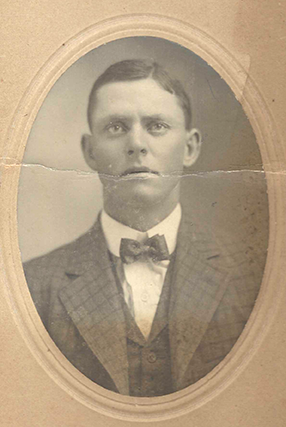
Ammie Ruble Kidd, 1885-1939
Mt Olivet Cemetery,
Tarrant County, TX
~~~~~~~
Song, song of the South
Sweet potato pie an' I shut my mouth
Gone, gone with the wind
There ain't nobody lookin' back again
Cotton on the roadside, cotton
in the ditch
We all picked the cotton but we never got rich
Somebody told us Wall Street
fell
But we were so poor that we couldn't tell
Cotton was short and the weeds
were tall
But Mr. Roosevelt's a-gonna save us all
Song, song of the South
Sweet potato pie and I shut my mouth
Gone, gone with the wind
There ain't nobody lookin' back again
-lyrics from Song of the South, by Alabama
To
the best of our knowledge, the six years they were married were spent
on the blackland farm that Ammie's parents gave him in the Forest Hill
community near Everman, TX when he married and went out on his own.
We aren't told how many acres that included, but the standard size for
a self-supporting farm in those days was 80 acres. We can only assume.
'Pickin' Time', a song by Johnny Cash,
is a must listen and very aptly tells the story of small family farm
life in those days.
During those six years, Meta gave A.R. (as he was called) three children;
a girl (Polly) born 9/7/1914, another girl (Rachel) born 7/7/1916, and
finally a boy (Fred) born on 3/21/1918. Just 18 months later on November
19, 1919, Meta passed away of unknown cause(s).

Perhaps it was chronic complications of childbirth, as was common in
those days, or perhaps it was disease that took her. We don't know.
We do know that during the years 1918-1920, an influenza pandemic (aka
Spanish flu) was world-wide and is estimated to have claimed approximately
675,000 lives in the United States. Meta is buried in Tarrant County
in Mt Olivet Cemetery in the J.R. Kidd
family plot.
A.R., being a poor farmer with three young children, apparently could
not afford a memorial marker or stone for her then marking her grave.
At one point years later, her son Fred attempted to mount an effort
among himself and his two older sisters, Polly & Rachel, to raise
the money for a memorial for their mother's grave, but was unsuccessful.
Now finally as of April, 2024 thanks to the children and grandchildren
of her son Fred, Meta now has a memorial stone on her grave in Mt Olivet
Cemetery. (see photo)
All we really know for sure is that A.R. was widowed for about a year and two months and somehow, difficult as it must have been, he and his three children survived without wife & mother.
FEBRUARY
2, 1921 - A.R. REMARRIES...
A year and two months after Meta passed away, A.R. married Fannie Lindauer
of Forrest City, St Francis County, Arkansas. She was born January 8,
1900 of German immigrant parents who taught their children the Christian
faith and to be frugal and hard-working. She was well educated compared
to others of her time, a tall, slim lady, very pretty, with beautiful
light blue eyes and long brown hair. The marriage took place in St Francis,
Arkansas. How or where they met to develop a relationship is not well
documented, and those who could have told us are no longer with us.
CLICK THE LINK BELOW FOR FANNIE'S STORY!
At
least one photo with a handwritten note on the back that Ammie sent
to Fannie before they were married has been preserved. (Click
here for photo and note) This photo was a picture of him, his
mother and brothers, which we can assume, was at least one way that
we can know A.R. did have an opportunity to introduce himself to her.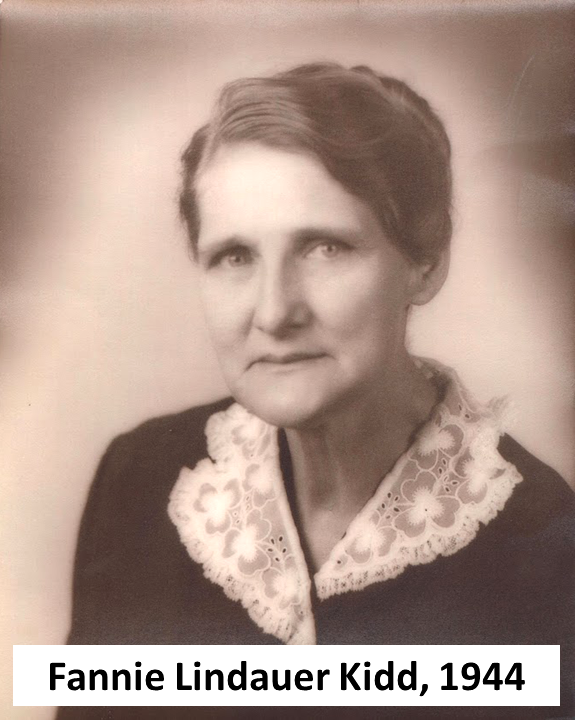
We
do know for a fact that Fannie's parents were immigrants from Germany
who had settled in Arkansas in the mid-to-late 1800's. In those days
it was common practice for European immigrants to the United States
to engage in arranged marriages for their eligible daughters. See
Fannie's story below.
**
Special section! **

Immediately
after their marriage, A.R. and Fannie traveled home to his blackland
farm in the Forest Hill community (Everman, Texas). We know that A.R.'s
mother, Rachel Susan, once again kept the three children while daddy
was off getting married. His young almost two-year old son, Fred, would
later tell the story of how while riding home in the wagon from Grandmother
Kidd's house, he ate too much from the sack of apples they had in the
wagon and got such a bad bellyache he crawled under the bed and wouldn't
come out!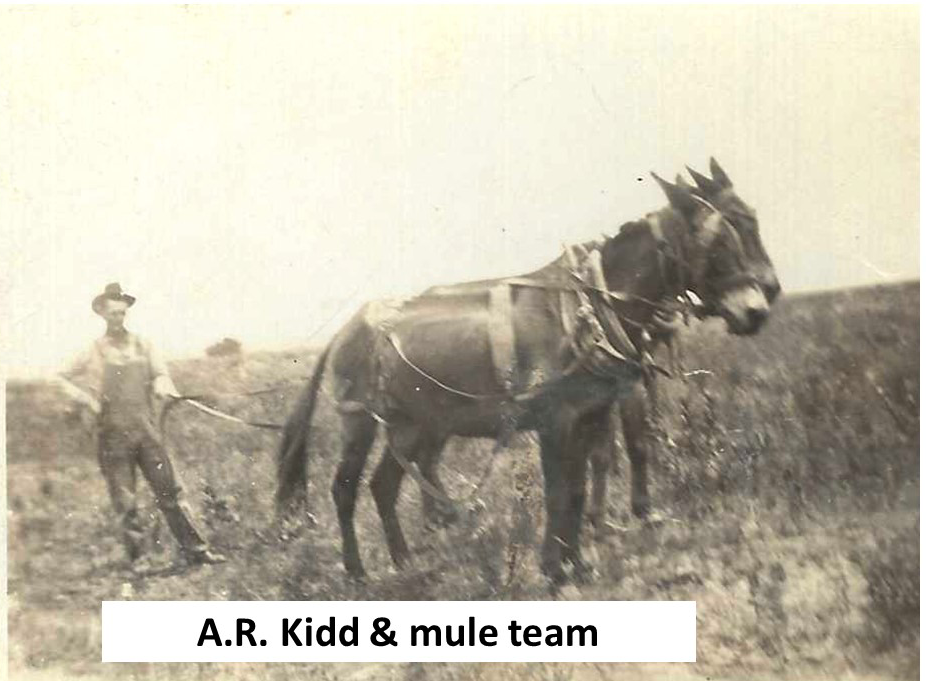
When they reached home it must have been obvious to young bride Fannie that the old farmhouse had seen better days. With only three small rooms, its cracked board walls let in the rain and snow. There was no water well, rainwater was caught in a cistern, and during dry spells if it was used up, A.R. would take his horse & sled to a neighbor’s well and bring back water in tubs.
Within
a year Fannie's first baby came. A.R. already had three children, so
that made for six people in a small three room house. Fannie accepted
all the children and loved them as her own. There was no electricity
on the place, no modern conveniences to make life easier. Washing of
clothes was done in an old iron pot, then scrubbed on a rub board and
hung outside to dry. There was no bathroom, an outhouse was down a long
path, and wash tubs were brought into the kitchen for baths. Fannie
would build a fire in the wood stove to cook meals three times daily.
Five children were born to A.R. & Fannie; a boy (Robert) born 12/18/1921,
a girl (Margaret 'Peggy') born 4/7/1924, another girl (Rosa 'Rose')
born 10/3/1927, a boy (Clarence Junior) born 5/16/1930, and another
(Walter 'Butch') born 2/3/1933.
KIDD
FAMILY FARM LIFE, 1921 to 1932... SPECIAL SECTION!
This special section is a narrative of farm life as seen through the
eyes of the children of Ammie & Fannie Kidd. It is definitely a
MUST READ to understand and appreciate our family's full story.

HARD
TIMES...
It was a very difficult time in the United States during the 1930's
as there was a great depression on. Wall Street had already crashed
on "Black Tuesday," October 29, 1929. Many banks failed, businesses
and individuals lost everything. Many major businesses failed as well.
But
Texas farmers, many of whom were sharecroppers and renters, were already
accustomed to some poverty, did not feel the worst of it at first. But
as crop prices continually fell, as drought got worse and worse, and
as profits dropped and debts rose, their situations worsened considerably.
Many lost their land to foreclosures or faced forced sale to government
building projects.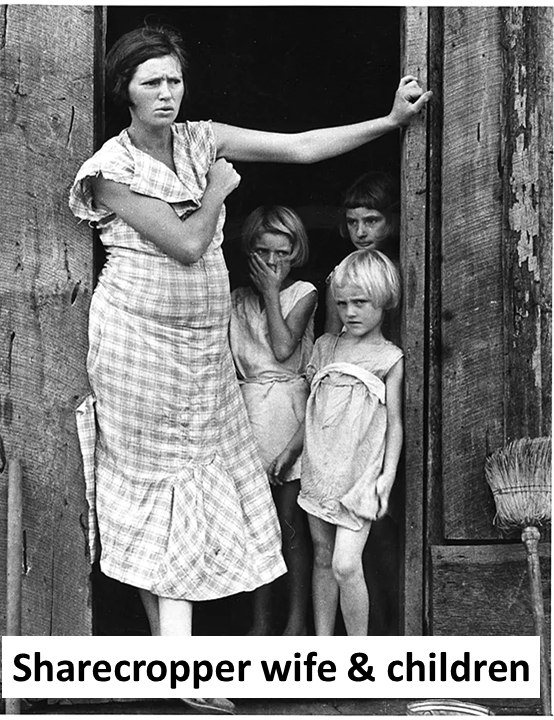
(AT RIGHT: Photo of sharecropper wife & children
courtesy Franklin D. Roosevelt Library, National Archives & Records
Administration)
A.R. was born and raised as a farmer and had no other skills, so the whole family had to work in the fields to have the bare necessities. Field work and harvest time had to take precedence over schooling and other social activities. Church on Sunday, which Fannie insisted on, was just about the only time neighbors and friends could be seen and talked to.
Rose & Clarence, Robert, Peggy, and Fred all shared memories of how Fannie's mother, Rosa Lindauer, came to visit them from Arkansas. And when she saw their poverty and severe needs, she sent a check to Fannie for $3,000. What an exciting blessing that must have been for a struggling family! Fannie promptly deposited it in a bank, but sadly, not long after that most of the banks in the U.S failed because of the Depression. The family did not get to use even a penny of the sorely needed money. A.R.'s mother, Rachel Susan, lost her savings as well. Her husband, James Randolph Sr had already passed away by 1926.
HARD
WORK FOR ALL...
There were now a total of ten in the family in that small board-walled
farm house. A.R. & Fannie's work load in the fields and in the home
must have been almost impossible, but their devotion to each other and
to their family kept them laboring day and night.
"The
corn is yellow and the beans are high,
The sun is hot in the summer sky.
The work is hard til layin' by,
Layin' by til pickin' time.
Layin' by til pickin' time."
Lyrics from 'Pickin
Time' by Johnny Cash.
Cotton sacks were important tools. Fannie made the cotton sacks for the family on her Singer sewing machine. When the kids were small, she took a flour sack and put a strap on it that went over the head. Flour was commonly purchased in 25 pound sacks at that time. The older kids got a cotton sack made out of cotton duck, which was tougher even than denim. These sacks would hold as much as 200 pounds of cotton.
Cotton
picking was a hard job as you had to pull the cotton from a boll on
the plant, and it had stiff, stickery leaves on the boll that would
prick your fingers bloody if you weren't careful. Plus, you had to bend
over to reach the cotton plants. Thus the old saying about people out
in the cotton field: "All you can see of them are '[butts] and
elbows'". Some of us often heard that saying in somewhat more 'colorful'
language that, instead of 'butt', used the more biblical name of the
donkey ;-).
Picking cotton and dragging a full cotton sack was quite literally back-breaking
work. 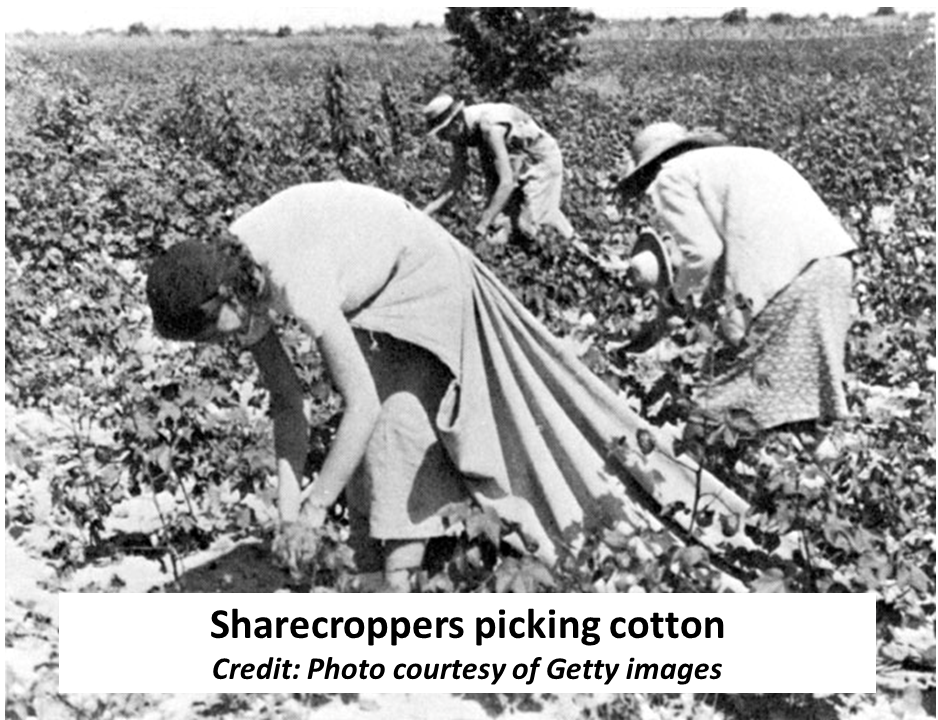
After
picking cotton all day, the hard work would continue at home because
supper had to be cooked and served. Cooking was done on either a wood
stove or on an old cranky kerosene stove. It was hard to get it started,
and then it smoked so bad.
Lots of the times supper was just fried potatoes, but boy after a hard
days work did they ever taste good! Red beans, sweet potatoes, and black-eyed
peas were eaten quite often too.
Fannie would sing hymns even in the worst of times, "Count your Blessings" was her favorite, along with "The Old Rugged Cross”. She would tell her children bible stories, thank God for her faith. Her children never forgot the stories, and passed their faith on to their children as well.
Everyone worked hard in the home as well as in the fields. On wash days Fannie would build a fire under the old black, three-legged iron pot and heat wash water. She would boil the dirtiest clothes, and then scrub them on the brass rub board. The soap was made from the fat of hogs and lye (lye soap).
The hot wash water was not wasted as it was then used to scrub the kitchen floor and the porches. How the girls dreaded wash day and then the next day was the ironing day, which was just as bad or worse than wash day. The irons were solid castiron and were so heavy and had to be heated on the stove. Sometimes they got too hot and scorched the clothes and then sometimes they would not be hot enough. In the summer it was worse as the house was already so hot and the added fire in the stove made it all the worse!
POOR
HEALTH...
There was no medicine or help for the family's many illnesses, pains
and aches, or money to buy it if it were even available. Fannie often
suffered from migraine headaches and would be almost incapaciated due
to the pain and nausea. We are not told exactly when or why, but at
one point she suffered a bout of sepsis (called blood poisoning) and
had to be hospitalized for treatment. Peggy said that she and her siblings
were very fearful their mother would die. Sepsis was then (and still
is) often fatal.
During these years, A.R. himself began to develop serious heart health issues, but would not tell anyone or talk about it, nor would he seek medical help. What good would it have done to tell anyone anyway? There were no treatments to speak of, and no way for a poor struggling farm family to pay for it even if there were, especially after the depression hit. But perhaps if at least his family had known of his heart disease it may have helped them to better understand some of the difficulties that were still to come.
We can now know that he developed congestive heart failure in the form of arterial sclerosis, probably hereditary, as one of his father's brothers had died suddenly from it, and some of A.R.'s sons and grandsons have developed heart problems of their own. In later years, Fannie's heart began to fail her as well. Considering all they had to endure, its not surprising.
Its
painful now to think of how they both must have struggled physically
and mentally to get through each day! Fannie led the family as best
she could using her staunch German upbringing to keep a thankful heart,
always singing and praising the Lord, and teaching her children to trust
in Him. We are left to wonder how they kept their family together at
a time when there was just no help, public or private, available from
anywhere.
In later years, A.R.'s oldest son (Fred) was known to say that he believed
the stress and hardship of the depression is what caused his parents
deaths so early in their lives. A.R. was only 54 when he passed away,
Fannie was only 49.
HARD
TIMES WORSEN...
The family's difficulties only got worse as the depression deepened.
When A.R.'s two girls who were born to Meta were older they were sent
to live with A.R.’s brother, Oliver Burnside Kidd and his wife Gertrude,
in Altus, Oklahoma on their farm. Aunt Gert was known to be a stern
disciplinarian and ran her household with a strict hand. Meta's son,
Fred, remained at home with his father, step-mother, and brothers and
sisters.
In 1932, as one of the US governments WPA projects (Works Progress Administration), A.R. and Fannie were forced to sell their farm to supply land to build a regional U.S. Public Health Hospital. When that happened the family moved temporarily to A.R.'s mother's old house at 405 Cromwell St in Fort Worth. This house was one of the first properties that A.R.'s father, J.R. Kidd, had purchased in the late 1880's when the KIDDs moved from Tennessee to the blackland prairie of north Texas. The family stayed there 16 months from June, 1932 to early November, 1933.
ANOTHER
FARM...
Later that November in 1933, we believe A.R. must have used the money
from the sale of their Everman farm to buy the old Hightower place,
a farm of about 80 acres in the Bransford community, which was about
three miles north of Smithfield. Bransford is in the area of what's
called the Grapevine Blackland Prairie and is known for good, productive
farm land.
We can only guess, but its doubtful A.R. was able to pay the entire
amount for the new place with the money the family received from the
government for the forced sale of their home farm. Likely he made partial
payment for the Hightower place and signed a promisory note for the
remaining amount with periodic payments to be made.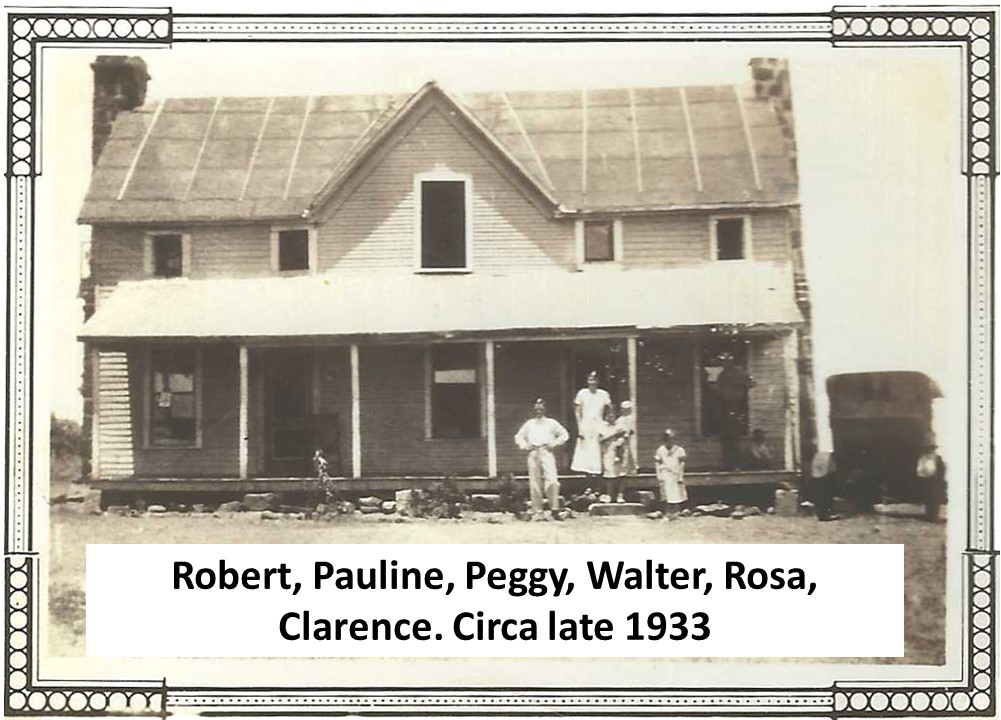
A.R. must have quickly discovered that he, as the saying goes, had ‘bitten off more than he could chew’ with this new place. Every piece of land has its challenges. Some of the black clay soil of the land was tightly packed, probably because it hadn't been cultivated in a long time, and other parts of the land were sandy but choked with thick bermuda grass, the root system which was also difficult to initially turn and plant. The family only had one mule to plow with and the plows and other implements were old and worn, definitely not up to the task of efficiently turning hard/stiff soil that had not been recently cultivated.
HEALTH
PROBLEMS MULTIPLY...
Something else A.R. very likely encountered that he probably did not
anticipate was his advancing heart disease. Anyone who has experienced
it knows the chest pain, the difficulty breathing, and the lack of energy
and stamina that comes with heart failure. This had to have been about
the time when A.R. finally discovered how bad off his heart really was.
Plowing behind a mule is strenuous work; but if you can't plow much, you can't plant much. No crops, no income. No income, and you can't pay your bills. It only took a year until the family had to give up the Hightower place and was forced to move again. Again we can only guess, but its very likely A.R. had to default on any note for the purchase of the land, thus his 'bad investment' his children talked about in later years that caused the loss of this farm.
OUT
OF NECESSITY...
Out of necessity the family was now mostly itinerant.
After leaving the Bransford farm came a succession of moves which A.R.
and Fannie kept hoping would better their family's situation. Without
a permanent home the family had to rent old houses to live in that were
often little more than shacks. There were probably as many as 18 to
20 different old places that Fannie had to clean to make them livable,
and to be nearer available work required frequent moves. Rent was usually
$5 per month, which seems like a small amount now, but during those
days of the Great Depression, $5 was extremely hard to come by.
GRAPEVINE,
TEXAS - 1934...
In November of 1934 one of the first moves was to the old Buckner rent
house about three blocks west of Main Street in Grapevine. The family
spent the Fall harvest season picking cotton for various people on the
Grapevine Prairie, and then spent the winter there. They did more spring
and summer farm work for others.
ALTUS,
OKLAHOMA - 1935...
The family then moved to Altus to help A.R.'s brother & sister-in-law,
Oliver Burnside (Uncle B) and Gertrude (Aunt Gert). They moved into
Uncle B's house and picked cotton for him in return for room and board
for the Fall harvest season. They likely also helped with other farm
work there until after Christmas, and then moved back to Texas.
**NOTE** This is probably when the decision was made for A.R.'s two
older girls, Polly & Rachel, to stay and live with Uncle B and Aunt
Gert. Polly would have been 21 by then, and Rachel 19. We know from
family records that both of these young women married and lived in Oklahoma.
FORT
WORTH, TEXAS - 1936...
The winter of 1936 the family moved back to Fort Worth and lived in
Grandma Rachel Kidd's rent house on Cromwell St. The family wintered
there doing what work they could find during that Spring and then moved
to S. Main St. of Ft Worth to another rent house.
GRAPEVINE,
TEXAS - 1936...
The family moved back to Grapevine in August, 1936 to be near the Grapevine
Prairie cotton fields and camped out in Moreland‘s tractor shed. Not
a real house, but having at least a roof over your head was better than
nothing. Everyone worked; A.R., Fannie, and all the kids all helped
with picking cotton, pulling & gathering corn, doing needed farm
chores for whoever was paying them. A.R.'s heart disease was probably
continuing to gradually worsen, but he somehow managed to function well
enough during these years to get by. He still refused to talk about
it and kept his disability to himself.
SOUTH
OF GRAPEVINE - 1936...
In November of 1936 the family moved to Elton Moreland's old house to
work for him during the Fall harvest and spent the winter there.
SOUTH
OF GRAPEVINE - 1937...
In the Spring of 1937, the family got the opportunity to continue work
on Moreland’s farm to help with spring planting and summer cultivation.
GRAPEVINE
PRAIRIE - 1937...
In the late summer of 1937 the family moved back to the Grapevine Prairie.
The best opportunities for work was there where all of the big cotton
farms were. Camping out and living anywhere they could they picked cotton
and did farm work through late summer 1938.
GRAPEVINE,
TEXAS - 1938...
For the Fall harvest in 1938 the family moved to the Horton Place off
FM 1709 near Grapevine. When there was time, the younger children went
to school at Grapevine. The cotton fields were out of town about 3 miles
from where they lived and they most often had to walk to school and
to work.
In late November the family moved to the old Buckner house in Grapevine,
which was somewhat closer to the work.
DEBILITATING
HEART DISEASE...
By this time, A.R's heart problems had apparently reached the point
where he could do little to no physical labor. His children did not
understand why he would not (could not?) help with the field work, and
thought it was selfish and mean of him to make them and their mother
do all the work. While they were all in the fields all they saw their
father do in those days was sit in the shade, weigh their cotton sacks,
and write the weights down in a little notebook.
Family lore has it that, at one point, Fannie had begged A.R. to at
least try to get a job with the WPA because they were starving. It is
told that he made some sort of excuse and refused.
Jobs with the WPA were mainly unskilled physical labor. Truth be known,
in his condition A.R. probably could not have even held a WPA job for
long because he couldn't do any physical labor due to the chest pain,
the shortness of breath, and the lack of energy. Why he continued to
keep his bad heart a secret is anyone's guess.
Probably the best most likely explanation is Ammie Ruble Kidd was a proud man tormented by the fact that he could not provide for his family. That great stress, plus the humiliation and self-condemnation only served to worsen the problem with his heart.
A.R. COLLAPSES SUDDENLY... The family moved southeast of Roanoke living as tenants on a farm and had not been there long when A.R. walked out of the house, followed by 11 year old daughter Rosa, and collapsed of cardiac arrest in June of 1939. Poor little Rosie witnessed her father’s death. He was not a lazy, mean old man, selfishly sitting in the shade while the rest of the family picked cotton in the hot sun. He was a man whose body failed him under the gravest of circumstances.
A.R.
did not have any life insurance, and Fannie was not old enough to draw
Social Security. Fannie couldn't pay for A.R.'s funeral so his brothers
pooled their money and paid it. Times were bad enough and now the family
had to live without husband and father. The oldest son was the only
one that could find any kind of steady work at the time, so they cut
wood and sold it at the Keller wood yard to make a little money.
Fannie could not drive the Model T that A.R. had owned, so she sold
it for what money it would bring and moved the family back to the blackland
prairie south of Grapevine.
GRAPEVINE
PRAIRIE - Summer 1939...
After that, the family moved to Massey's place on the Grapevine prairie
where they could do farm work to pay their rent. While there, the oldest
son worked for Mr. Massey and went to welding school and machine shop
school.
OUT
OF DIRE NECESSITY...
Fannie was now faced with the huge problem of raising her family without
any support at all, with no income except what they could earn in the
fields and what the two oldest boys could bring home. They walked to
work, no matter how far it was from home and Fannie always went with
her family, never just sent them. She worked harder and pushed herself
harder than any of them. Sometimes she was given the cull produce that
didn't sell, so she and her children carried the heavy baskets home.
After feeding everyone their evening meal, she would set about to preserve
it; preparing, washing, parboiling and finally putting it into the jars
that had been scrubbed clean. The pressure cooker required heat, so
the stove had to be heated, all of this in a house that was already
miserably hot. She must have been up so late and then to bed so exhausted,
with nothing to look forward to but the same miserable labor the next
day.
GRAPEVINE
- Fall 1939...
The family moved back to Grapevine that Fall and picked cotton. They
lived in five or six different rent houses south of Grapevine, moving
frequently to stay close to the work. The oldest son continued the welding
& machine shop schooling, and the next to oldest son worked for
a Mr. Swentner on his dairy. The family was able to move into one of
Swentner's houses that was on his property and were able to live there
a long time.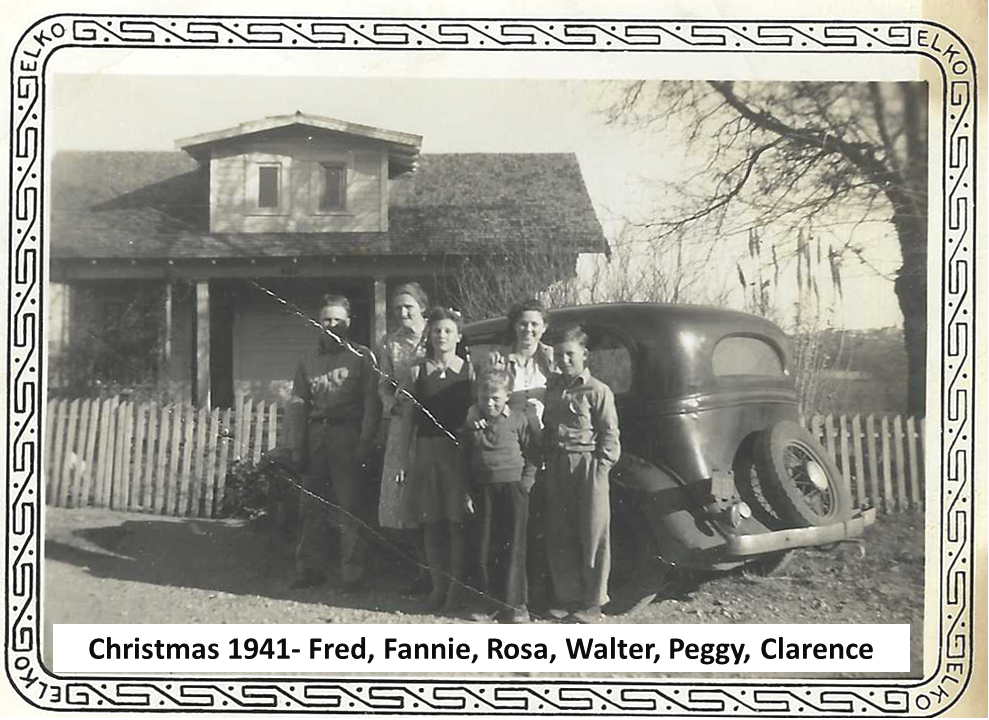
LATE
1941 - EARLY 1942...
As World War II began to loom closer in late 1941 & early 1942,
the family's two oldest boys were drafted into military service. While
they were overseas, both of them did the best they could to send money
home to Fannie and their younger brothers and sisters.
THE
WAR YEARS...
In late 1942, with both older boys gone off to war, Fannie and the four
younger children, ages 9 thru 18, all surely must have continued to
struggle to eek out a living as best they could. We know next to nothing
about where they lived or what they did for work during the war years.
Their written memories don't tell us much, so we can only assume that
they continued schooling, which Fannie insisted on, and worked at whatever
jobs were available to bring their earnings home to their mother.
AFTER
WW2...
1945 - Peace time finally came and by 1946 the two older boys, Fred
and Robert, returned home from their overseas military service. Butch
also served in the miliary for some years after the war. By then, Clarence
at the age of 15, was doing what he could to help support the family.
The two girls, Peggy and Rose were either already married or would soon
be. All three boys would also soon find wives and settle down to begin
their own families.
As for Fannie, when her developing heart trouble got so bad that she had to see a specialist, she would walk many miles to Grapevine to catch the Greyhound bus to Fort Worth, and from the bus station then walk to the doctor's office. After seeing the doctor, she would have to walk back to the bus station, and again walk back home from Grapevine. Sometimes the doctor would admit her to Harris Methodist Hospital to stay a few days.
Grandchildren
began to be born to Fannie, and by early 1949 she'd had the joy of holding
the firstborns of Rachel, Fred, Robert, Peggy, and Rose.
That same year Fannie's sister, Rosa Moore in Arkansas, sent her a small
amount of money. It was not really enough for a house and lot, but with
the help of her children she was able to pay for a small house near
Smithfield. It was modest, but was a castle to Fannie. No more would
she have to worry about rent, no more carrying water from a well, no
more starting wood fires for she would have gas heating and cooking.
No more walking down a path to an outhouse, for there was water piped
in the house with indoor plumbing and a big bathtub instead of a wash
tub! Now she would have electricity! What unbelievable luxuries!
But even then Fannie was not to enjoy her new castle for long. God in
His Infinite Mercy and Wisdom called her home after only three months
in her new home. Sadly, most of that time was spent in the hospital.
Finally, on a cold day in December just two days after Christmas, she
passed away. She was only forty nine years old.
To include your stories and other information in this site,
Email us at Webmaster.
Comments,
suggestions,
additional info are
always welcomed.,
Please contact: Webmaster
